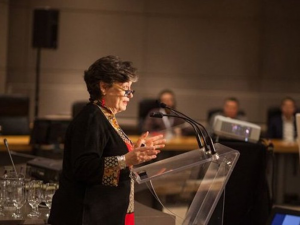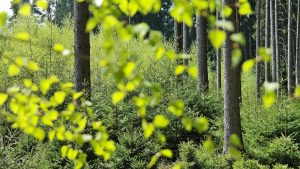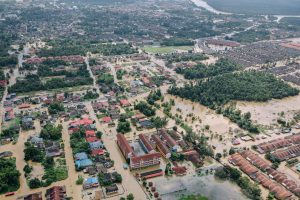
Interview with Colleen Mercer Clarke.
In the interview, Colleen Mercer Clarke talks to us about the challenges and opportunities that landscape architects are facing today.
Dr. Mercer Clarke is an interdisciplinary scientist and landscape architect specializing in advancing resilience through the delivery of useful science on climate change to communities, business and governments.
She is an advocate for ecosystem-based approaches to planning and design, and for the continued strengthening of efforts to protect, restore, and to sustain our natural world.

Colleen Mercer Clarke.
Photography: Colleen Mercer Clarke
In addition to on-going national and international advisory roles on climate policy and action, Colleen served as Chair of the CSLA Committee on Climate Action, Chair of the International Federation of Landscape Architect’s Working Group on Climate Change (IFLA), and as Chair of the International Federation of Landscape Architect’s Committee on Professional Practice and Policy (2020-2022).
Currently she serves the profession as the IFLA Special Envoy and Voting Member to the International Union for the Conservation of Nature, and the Canadian Society of Landscape Architects as the Senior Advisor on Adaptation and Biodiversity.
In 2009, Colleen was elected to the College of Fellows of the Canadian Society of Landscape Architects. In recognition for her work on climate adaptation, in 2016 she was the recipient of the CSLA President’s Award and in 2019 was the recipient of the President’s Award of the International Federation of Landscape Architects. As both a landscape architect and a marine ecologist, Colleen is a champion for the protection of biodiversity in all spaces at all scales.

Colleen Mercer Clarke.
Photography: Colleen Mercer Clarke.
HOW LANDSCAPE ARCHITECTS HELP MITIGATE CLIMATE CHANGE?
Landscape architects, whether in government, academia or professional practice, work at the interface between the built environment and the natural environment. Our profession is uniquely placed to advance efforts to mitigate climate change through our work to ensure that all decision-making systems are supported by policy and processes that don’t just allow for changes but that support innovation and creative alternatives to business as usual.
Of course, we must ensure that through our own work every effort is made to reduce the carbon footprint of our projects. To ensure that we protect the natural systems at work on our sites, and that we seek methods and materials that reduce greenhouse gas emissions through the entire life cycle of our projects, and through the life cycles of the materials that we use.
Most importantly, we can work to protect the ecosystems we have, to restore and enhance those that we have damaged and to seek opportunities to create habitats and ecosystems at all scales from tiny urban pocket parks to large landscape management. Climate change is a massive threat to environments and to societies, but an even larger threat is looming throughout the globe, the loss of biodiversity in all nations, on all landscapes- terrestrial, aquatic and marine.

Protect nature.
Photography: https://www.pexels.com/es-es/foto/enfoque-selectivo-de-plantas-414798/
WHAT PRACTICES AND STRATEGIES SHOULD LANDSCAPE ARCHITECTS IMPLEMENT TO PREVENT FLOODING IN CITIES?
Some urban flooding can be the result of insufficient or badly designed stormwater management systems unable to accommodate for the 1:500 years and more storms that are now occurring across the globe. Overland flooding can also result from changes in global and local mean sea levels, exacerbated by storm surges often associated with increasingly severe weather events.
Landscape architects working individually and in interdisciplinary teams are seeking new ways to capture, manage and reuse precipitation, and to protect infrastructure and people from flooding through innovative new approaches that see water as an important resource. Rain city and sponge city strategies seek to find new ways to collect, store and release precipitation so as to slow and to reduce its impacts on urban infrastructure, and to ensure that every drop of water is cleaned and reintroduced to our systems to support improved quality of life for urban populations, while reducing impacts to already overburdened infrastructure.
Advocating for 30% area coverage for urban canopies is one of many approaches where one metric can both improve the capacity of a community to manage its precipitation, while opening access to green space that will shelter human populations from heat and storms, and improve our sense of wellbeing.
“Rain city and sponge city strategies seek to find new ways to collect, store and release precipitation so as to slow and to reduce its impacts on urban infrastructure.”
Prevention of flooding in intensively settled landscapes may not always be possible. Landscape architects, working with planners, developers, and other decision-makers can develop new approaches to living in concert with a changing environment through advocacy for construction set-backs, changes to land use in flood plains, and to moderating human activities in areas under threat.
All of these and other mechanisms must be balanced through application of ecosystem-based approaches to planning and design (including nature-based solutions) and with careful and sensitive attention to social justice and to the direct and indirect impacts to urban populations.

Floods.
Photography: https://www.pexels.com/es-es/foto/ciudad-naturaleza-agua-pueblo-6471926/
WHAT IS THE BIGGEST CHALLENGE LANDSCAPE ARCHITECTS ARE FACING NOWADAYS?
Our profession faces many changes today, especially as the landscapes in which we work are already being affected by a continuing, and sometimes escalating, change in environmental parameters we had come to rely upon as being stable and dependable. However, perhaps our greatest challenge is the increasingly important role we as a profession can and must play to aid society and environments to face these coming changes.
Although we are great communicators, we have not been present in many of the fora where policy and practice decisions take place. We have not been a united voice for change to “business as usual”. This must change.
Every landscape, every nation, every community faces immense challenges from climate change, severe weather, biodiversity loss, strife and human well-being. The society and the environment we have sought to serve now needs our profession more than ever, whether it is advocating for urban tree planting, neighborhood food gardens or standing as the last protection for a stand of forest or a wetland. We must not merely be a voice for change, we must be a force for change.
“We must not merely be a voice for change, we must be a force for change.”











